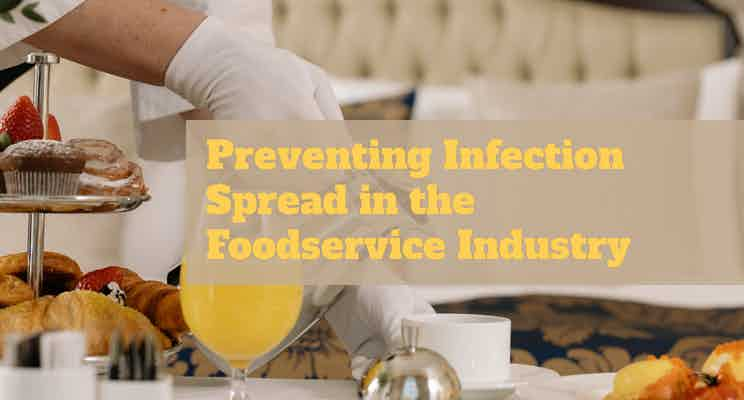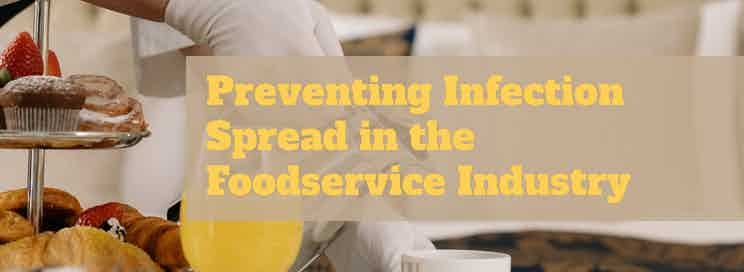The COVID-19 pandemic resulted in numerous changes to the foodservice industry that present additional infection prevention challenges.

Infection Prevention Challenges Facing the Foodservice Industry
Over the last two years, the foodservice industry has experienced monumental shifts in how it is required to serve customers--from delivery or curbside-only pickups to outdoor dining and limited indoor capacity.
Presently, many establishments operate within some hybrid framework that includes most, if not all, of these dining and delivery configurations.
Of concern--these new methods for getting food from the kitchen to the customer create additional touchpoints, which means new infection prevention challenges.
- Third parties often perform deliveries that must maintain hand hygiene and sanitation oversight for the drivers and their vehicles.
- Outdoor areas are often accessible to pests, increased dust, and other microbes, adding additional cleaning requirements and presenting additional health risks.
- Allowing indoor dining likely requires increased cleaning and sanitization frequencies of high-touch surfaces and restrooms, and;
- Staffing shortages have likely compounded the complexity of consistently maintaining high-level cleaning outcomes, especially where training is lacking.
Increased Industry Demand and Increased Profits
Despite the challenges, restaurant dining and takeout have grown exponentially over the last two years--a trend that does not appear to be slowing down.
In addition to the increased industry demand, diners choosing to dine-in (even when it's outdoors) do so with heightened expectations of cleanliness and safety and a willingness to pay more for the privilege.
Food and beverage sales in the restaurant and foodservice industry are up 19.7 percent from 2020, with projections estimated to total $789 billion for 2021, according to the National Restaurant Association.
Also on the uptick: higher expectations around restaurant cleanliness.
Though it’s always a priority for consumers, concern about food service cleanliness and sanitation practices is now consistently at the top of diner’s minds, according to a survey by Simon-Kusher & Partners and reported in QSR Magazine.
Research shows that customers will even pay a premium — almost twice the price — at restaurants that meet their elevated cleanliness standards.
Creating Better Foodservice Hygiene Outcomes
Establishing several cleaning and hygiene protocols now will help ensure better future outcomes.
- Auditing - All current operations and touchpoints should be audited for risk. Risk mitigation methods should be assessed for effectiveness. Ongoing auditing protocols should be established to ensure the efficacy of continuing health and hygiene efforts.
- Training - Everyone, including diners, are responsible for safety and hygiene. Handwashing signage should be placed in restrooms demonstrating proper handwashing techniques for diners and staff. Fomites should be identified, and the team tasked with sanitizing these points should be trained regarding when and how these surfaces should be sanitized. Restroom, dining area, and kitchen sanitation are paramount, so individuals responsible for cleaning these areas should be thoroughly trained in all areas of cleaning and infection prevention methods, especially cross-contamination prevention. Additional training requirements regarding safe product handling and disposal should be emphasized for all team members.
- Products - Correct product selection is critical for ensuring maximum infection prevention program efficacy. All products should be registered as appropriate for the surface they are used on and meet industry requirements. Additionally, products should be registered with the EPA as effective against the broad spectrum of germs and bacteria typically encountered in the foodservice industry but safe for use on food surfaces.
One final aspect highly relevant to the foodservice industry, though not explicitly related to cleaning and infection prevention protocols, is waste diversion, particularly in California.
State legislation requiring the separation of organic waste took effect at the start of 2022.
Restaurant owners and facility managers will need to ensure all waste is disposed of according to the new requirements, in addition to meeting California's other recycling requirements and consumer sustainability demands.
Takeaway
The increasing complexity and cost of maintaining a clean and safe restaurant could easily eclipse the new profits the foodservice industry is experiencing.
Outsourcing to a LEED-certified janitorial service provider will significantly reduce overhead, risk, and complexity while ensuring high-level outcomes.
Outsourcing is a proven method for onboarding highly in-demand cleaning and sanitization services and experience for a fraction of the price of maintaining a similar service in-house.
If you would like more information regarding the effectiveness of high-performance infection prevention and control measures, or if you would like to schedule a free, no-obligation on-site assessment of your facility's custodial needs, contact us today for a free quote!
In Bakersfield, CA, call (661) 437-3253
In Fresno, CA, call (559) 206-1059
In Valencia, CA, or Santa Clarita, CA, call (661) 437-3253
In Palmdale, CA or Lancaster, CA, call (661) 371-4756

